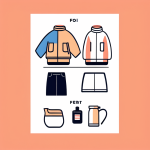Introduction to Puffer Jackets and Water Resistance
Are puffer jackets waterproof? Puffer jackets, known for their quilted design and insulation, are a winter staple. They are warm, lightweight, and comfortable. But when it comes to water resistance, there’s often confusion. Not all puffer jackets can repel water well. Water resistance in these jackets depends on the fabric and the coatings used. Some puffers come with water-resistant treatments, while others do not.

Materials like polyester and nylon, often found in puffer jackets, provide some resistance to water. However, without a proper coating, these materials will not keep you dry in heavy rain. Durable Water Repellent (DWR) coatings help. They add an extra layer of protection. This layer makes water droplets bead up and roll off the fabric instead of soaking in.
Still, are puffer jackets waterproof? Generally, no. Most puffer jackets are water-resistant — they can handle light rain or snow. With a DWR coating, they might withstand a downpour for a short time. But for long-term exposure to heavy rain, a waterproof jacket is better. Waterproof jackets use different materials and construction techniques. They often include sealed seams and a waterproof membrane. These design features block water completely.
Whether or not a puffer jacket will keep you dry depends on the specific jacket and its features. It’s important to know the difference between water-resistant and waterproof when shopping. Always check the label or product description for details about the jacket’s abilities. Some puffer jackets also include waterproof sections or features, combining the benefits of both designs.
In the next sections, we will explore the materials used in puffer jackets, how these affect their water resistance, and more. This will help you understand what to look for and how to care for your puffer jacket.
The Materials Used in Puffer Jackets
When selecting a puffer jacket, the material plays a critical role in water resistance. Puffer jackets are usually made from synthetic fibers, like polyester or nylon. These materials have inherent qualities that provide some degree of water resistance. Nylon, in particular, is known for its durability and resistance to abrasion. It tends to be more water-resistant than polyester. However, neither material is fully waterproof on its own.
The level of water resistance in a puffer jacket also hinges on the weave of the fabric. A tighter weave can increase the material’s ability to resist water. But still, this does not make the jacket waterproof. Water can eventually seep through, especially in heavy rain.
Many manufacturers use a combination of these materials. They sometimes also blend in natural fibers to improve comfort and breathability. But this can affect the jacket’s water resistance. Natural fibers like down are excellent for insulation. They keep you warm by trapping heat. Yet, they absorb water and take a long time to dry. This is why many puffer jackets feature a synthetic insulation or a water-resistant down.
In short, the materials used in puffer jackets can resist water to an extent. But for true waterproofing, additional treatments or coatings are necessary. Keep this in mind when you shop for your jacket.
Factors Affecting the Waterproof Nature of Puffer Jackets
Understanding the factors that determine whether a puffer jacket is waterproof is crucial. Various aspects contribute to a jacket’s ability to keep water out. Here are some of the most significant factors:
- Fabric and Material: As mentioned, materials like nylon and polyester offer some degree of water resistance. The water-repellent ability of these synthetic fabrics is due to their tight weaves and fibers.
- DWR Coatings: A durable water repellent (DWR) coating can greatly enhance water resistance. This coating causes water to bead and roll off the surface, rather than soaking into the fabric.
- Seam Sealing: Non-waterproof jackets often have seams through which water can penetrate. Waterproof jackets typically have taped or sealed seams to prevent water from seeping in.
- Zippers and Closures: Water can enter a jacket through zippers and pocket closures. Jackets designed for waterproofing often have waterproof zippers or protective flaps over zippers.
- Lining and Insulation: How a jacket is lined and insulated also plays a role. Water-resistant down or synthetic insulation can help preserve warmth even when wet, but it does not ensure waterproofing.
- Construction and Design: Overall design can affect water resistance. Jackets with fewer panels and gaps have less space for water to find its way inside.
In summary, for a puffer jacket to be considered waterproof, it requires not just the right materials but also appropriate construction methods. Features like DWR coatings, seam sealing, and water-resistant closures support a jacket’s waterproof nature. However, it’s important to acknowledge that most puffer jackets are designed mainly for insulation and may only offer basic water resistance. Always check the product details to understand the level of protection you can expect from a puffer jacket.

Comparing Water Repellent and Waterproof Jackets
When shopping for outerwear, understanding the difference between water repellent and waterproof jackets is key. Here’s a comparison to help you make an informed choice:
- Water repellent jackets have a coating that fends off water. This means water droplets bead up on the surface and roll off rather than soaking into the fabric. They are suitable for light rain or snow but may not hold up under a serious downpour.
- Waterproof jackets offer a higher level of protection. They feature a waterproof membrane or layer that completely blocks water. Seams are usually sealed to prevent leaks. These jackets are the best bet in heavy rain or wet snow.
To sum it up, water repellent jackets can handle light moisture and are good for casual use. Waterproof jackets, on the other hand, are built for harsh weather. They keep you dry even during prolonged exposure to water. When deciding which to buy, consider how much time you’ll be spending in wet conditions and what level of protection you need.
Enhancing the Water Resistance of Your Puffer Jacket
If you have a puffer jacket and want to improve its water resistance, you can take several steps. Here are key ways to boost the water-fighting capabilities of your jacket.
- Use a DWR Spray: Apply a durable water repellent (DWR) spray. This adds a water-resistant layer to the fabric. Make sure the jacket is clean before you spray. Follow the instructions carefully.
- Reapply DWR Regularly: Over time, the DWR coating can wear off. You’ll need to reapply it periodically. How often depends on how much you wear the jacket and exposure to the elements.
- Wash with Care: Washing can damage a jacket’s water resistance. Use a gentle cycle and a detergent made for water-repellent fabrics. Avoid fabric softeners, as they can strip the DWR coating.
- Seal the Seams: If your jacket’s seams are not sealed, you can use a seam sealer. This prevents water from seeping through stitches.
- Check Zippers and Closures: Make sure zippers and closures are in good condition. Replace any that are broken or leaking. Consider using a zipper guard for extra protection.
- Store Properly: When not in use, store your puffer jacket in a dry, cool place. Keep it off the floor and away from direct heat sources.
By following these steps, you can help ensure your puffer jacket stays more water-resistant. Remember, even with these measures, most puffer jackets won’t become waterproof. But they can handle wet weather better. Always read the jacket’s label for specific care instructions.

When to Choose a Puffer Jacket Over a Raincoat
When you’re dressing for the weather, it’s important to know when a puffer jacket is the better choice over a raincoat. Here are some scenarios where a puffer jacket might serve you well:
- Temperatures are Cold: If the weather is chilly, a puffer jacket offers the insulation you need. Its main aim is to keep you warm.
- Light Precipitation: For light rain or snow, a water-resistant puffer jacket can fend off moisture. This is fine if you won’t be outside for long.
- Casual Outings: When stepping out for a short time, and it’s not pouring rain, a puffer jacket can be the comfier choice. It’s easy to wear and good for everyday use.
- Layering: Puffer jackets are great for layering. You can wear one under a shell for extra warmth. This is ideal for outdoor activities where you might start to feel cooler.
- Style Preference: Sometimes, the choice is about looks. Puffer jackets can be more stylish and suit your aesthetic better than raincoats.
In contrast, opt for a raincoat if:
- Heavy Rain is Expected: When facing a downpour, a raincoat’s waterproof features will keep you dry. It’s made for this type of weather.
- Long-Term Exposure: If you’ll be outdoors for a long time in wet conditions, a raincoat is the safer bet to ensure dryness.
By considering these factors, you can make the best choice for comfort and protection against the elements.
Maintenance Tips for Prolonging Water Resistance
Proper maintenance can stretch a puffer jacket’s ability to fend off water. Here’s how:
- Regular Cleaning: Dirt and oil buildup can affect the coat’s water resistance. Clean your puffer regularly following the manufacturer’s instructions.
- Use Specialized Products: For washing, pick a detergent made for water-resistant garments. This helps maintain the DWR coating.
- Avoid Harsh Chemicals: Steer clear of bleach and fabric softeners. They can degrade the water-repellent properties of your jacket.
- Low Heat Drying: After washing, use a low heat setting in the dryer. This can reactivate the DWR treatment.
- Timely Reproofing: If water stops beading, it’s time to reapply a DWR spray or wash-in product.
- Handle With Care: Avoid rough surfaces that can create tiny tears in the fabric. These tears can let water seep through.
- Proper Storage: Keep your jacket in a cool, dry place out of direct sunlight when not in use to prevent wear.
By following these straightforward steps, you can help your puffer jacket resist water better and last longer.
Conclusion: Making the Right Choice for Your Needs
When you’re in the market for a puffer jacket, water resistance is an important factor to consider. Understanding the difference between water-resistant and waterproof is key to making the right choice. Water-resistant puffer jackets can handle light rain and snow, which is great for cold weather and short outdoor sessions. Waterproof jackets, on the other hand, are a must when you’re facing heavy rain or prolonged exposure to wet conditions.
Remember to look at materials, design, and additional features like DWR coatings and sealed seams. These decide how well a jacket will keep you dry. Don’t forget the importance of proper care. Regular maintenance, including reapplying DWR and avoiding harsh chemicals, helps keep your puffer jacket in top water-fighting shape.
At the end of the day, the decision falls to your lifestyle and weather encounters. If warmth and light precipitation protection are your goals, a puffer jacket will suit you. If staying dry in a downpour is critical, choose a specialized raincoat. Whatever your choice, ensure it aligns with your needs for the best experience in the great outdoors.


